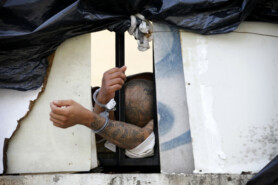Posted on 16 Feb 2018
Mara Salvatrucha, or MS13, is one of the world’s largest and most violent street gangs. It is also one of the least understood, making it difficult for policymakers and law enforcement to confront. A new report by InSight Crime and American University’s Center for Latin American & Latino Studies (CLALS) reveals new details about the gang’s operations and provides policy prescriptions for eradicating MS13.
Entitled “MS13 in the Americas: How the World’s Most Notorious Street Gang Defies Logic, Resists Destruction,” the report is based on hundreds of interviews with, and surveys of gang members and law enforcement officials in El Salvador, Washington, D.C., Los Angeles, and Long Island. It contains insights into the gang’s hierarchy, politics, structure, and recruitment methods.
“This is the first report that looks at the gang from a regional perspective and tries to analyze all of its facets, from MS13’s criminal economy to the sources of its violence, to its migration patterns,” said Steven Dudley, InSight Crime’s Co-director and a fellow at the American University’s Center for Latin American & Latino Studies, who was the study’s lead researcher.
Among the report’s numerous ground-breaking findings, the researchers reveal that far from being simply an international drug-trafficking ring, MS13 is a hand-to-mouth criminal organization that relies mostly on extortion for its revenue. Contrary to widespread claims that the gang dispatches members to set up new cells in the United States, the group takes advantage of existing migration patterns, the researchers learned.
The study also demonstrates that MS13 is a diffuse organization composed of many layers, with no single leader or leadership structure that directs the entire gang. Above all, it is a social organization first, and a criminal organization second, where loyalty, not profit, is the primary driver of members’ actions.
In fact, Dudley and his colleagues report, MS13 has survived for almost four decades without a master plan, without a single all-powerful leader, and without a reliable source of income. Its core membership consists of teenagers who communicate mostly via text messages, and its messaging is conveyed with spray paint. Many of its leaders are in jail, and the majority of its members did not complete high school.
Despite facing fierce efforts to dismantle it by the governments of the United States, Guatemala, Honduras, El Salvador, Italy and Spain, MS13 continues to thrive. According to the report, the gang is experiencing a resurgence in areas along the U.S. East Coast, and creating new gang units in rural California and major urban centers in Europe.
“The gang is a study in contrasts — a violent criminal group, to be sure, but also part social and part political,” the report says. “It is a group that can fill basic human needs just as easily as it can end a human life. It can move drugs over international borders, but has a difficult time paying its members a living wage.”
The researchers found that these divergent characteristics help explain the contradictory assessments of the gang by law enforcement agencies and academic researchers alike. Some consider MS13 to be a transnational criminal organization, capable of orchestrating cross-border assassinations and trafficking illicit drugs. Others believe that it is a dangerous but predictable response to abuse and social exclusion. The researchers contend that, because the gang encompasses all of these characteristics and many more, efforts to eradicate MS13 have been stymied.
“In order to dismantle the gang, we have to understand it from the inside out, get at its social and political functions, and see it for what it is: a part of our fractured Latin American community in the United States,” said Héctor Silva Ávalos, an InSight Crime investigator and fellow at CLALS, who helped research the report in El Salvador and Washington, D.C.



